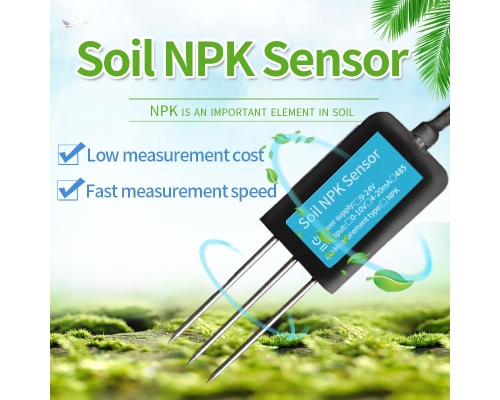The agricultural sector stands at a pivotal juncture in its evolution, transitioning from traditional practices to a future defined by precision, efficiency, and sustainability. Central to this transformation is the integration of innovative technologies, among which soil sensors emerge as game-changers. These devices, leveraging cutting-edge advancements in sensor technology, IoT (Internet of Things), and data analytics, are reshaping the landscape of farming by providing real-time insights into soil conditions. This article delves into the multifaceted impact of innovative soil sensors on smart agriculture, exploring their mechanisms, applications, benefits, and future prospects.

Understanding Soil Sensors
Soil sensors are devices designed to measure various physical, chemical, and biological parameters of soil, such as moisture content, temperature, pH levels, nutrient concentrations, and electrical conductivity. These sensors operate on diverse principles, including capacitance, time-domain reflectometry (TDR), and spectroscopy, each offering unique advantages in terms of accuracy, cost, and deployment. The advent of low-cost, miniaturized sensors has democratized access to soil data, enabling farmers of all scales to harness the power of precision agriculture.
Mechanisms and Technologies
- Moisture Sensors: Utilizing capacitance or TDR techniques, these sensors gauge soil moisture levels, a critical factor influencing plant growth and water management strategies. Real-time moisture data helps farmers optimize irrigation schedules, reducing water waste and enhancing crop yields.
- pH and Nutrient Sensors: Electrochemical sensors measure soil pH and nutrient concentrations, providing insights into soil fertility and nutrient availability. This information guides precise fertilization practices, minimizing environmental pollution and promoting sustainable agriculture.
- Temperature Sensors: Monitoring soil temperature is vital for understanding microbial activity, nutrient cycling, and plant development. Temperature sensors help farmers tailor their practices to seasonal variations, ensuring optimal growing conditions.
- Electrical Conductivity Sensors: These sensors assess soil salinity, a critical parameter affecting plant health and productivity. High salinity levels can impede water uptake and nutrient absorption, necessitating targeted management strategies.
Applications in Smart Agriculture
- Precision Irrigation: By integrating soil moisture sensors with IoT platforms, farmers can automate irrigation systems based on real-time data. This precision approach ensures that crops receive the right amount of water at the right time, reducing water consumption and improving water use efficiency.
- Fertilizer Management: Nutrient sensors enable variable-rate fertilization, where fertilizer application is adjusted according to soil nutrient levels and crop requirements. This targeted approach minimizes fertilizer runoff and leaching, preserving water quality and reducing greenhouse gas emissions.
- Crop Health Monitoring: Continuous monitoring of soil parameters allows farmers to detect early signs of stress or disease in crops. By correlating soil data with plant health metrics, farmers can implement timely interventions, preventing yield losses and enhancing crop quality.
- Yield Prediction and Harvest Planning: Aggregating soil data with weather forecasts and historical yield records enables accurate yield prediction. This information supports strategic harvest planning, logistics optimization, and market decision-making.
Benefits of Soil Sensors in Agriculture
- Increased Efficiency and Productivity: Precision agriculture, facilitated by soil sensors, optimizes resource utilization, leading to higher crop yields and reduced input costs. Farmers can make data-driven decisions, enhancing operational efficiency and profitability.
- Sustainability and Environmental Stewardship: By minimizing water and fertilizer use, soil sensors contribute to sustainable farming practices. Reduced chemical inputs and optimized irrigation mitigate environmental impacts, preserving natural resources for future generations.
- Risk Mitigation: Real-time soil data enables farmers to anticipate and respond to adverse conditions, such as droughts, floods, or nutrient deficiencies. This proactive approach enhances resilience against climate variability and market uncertainties.
- Enhanced Decision-Making: The integration of soil sensors with data analytics platforms provides actionable insights, empowering farmers to make informed decisions. Data-driven agriculture fosters innovation and continuous improvement in farming practices.
Challenges and Considerations
Despite their potential, the widespread adoption of soil sensors faces several challenges:
- Cost and Accessibility: While the cost of sensors has decreased, initial investment and maintenance expenses remain barriers for small-scale farmers. Innovative financing models and government subsidies can enhance accessibility.
- Data Management and Interoperability: The proliferation of sensor technologies generates vast amounts of data, requiring robust data management systems. Ensuring interoperability between different sensor platforms and agricultural software is crucial for seamless integration.
- Technical Literacy and Training: Farmers need adequate training to operate and interpret sensor data effectively. Developing user-friendly interfaces and providing technical support can bridge the knowledge gap.
- Privacy and Security: As agricultural data becomes increasingly digitized, ensuring data privacy and security is paramount. Implementing robust cybersecurity measures and adhering to data protection regulations are essential.
Future Prospects and Innovations
The future of soil sensors in agriculture is marked by exciting innovations and advancements:
- Integration with Emerging Technologies: The convergence of soil sensors with AI, machine learning, and robotics will unlock new possibilities. Predictive analytics can forecast soil conditions, while autonomous drones and robots can perform site-specific interventions based on sensor data.
- Nanotechnology and Biotechnology: Nanosensors and biosensors offer enhanced sensitivity and specificity, enabling the detection of trace elements and biomarkers in soil. These technologies hold promise for early disease diagnosis and precision agriculture.
- Blockchain and Smart Contracts: Blockchain technology can ensure the traceability and authenticity of agricultural data, fostering trust and transparency in supply chains. Smart contracts can automate transactions based on sensor-triggered events, streamlining agricultural operations.
- Global Collaboration and Standardization: International cooperation in sensor research and development can accelerate innovation and address global agricultural challenges. Establishing common standards and protocols will facilitate the adoption of soil sensors worldwide.
Conclusion
Innovative soil sensors are at the forefront of the smart agriculture revolution, transforming traditional farming practices into data-driven, efficient, and sustainable operations. By providing real-time insights into soil conditions, these sensors empower farmers to make informed decisions, optimize resource utilization, and enhance productivity. While challenges remain, ongoing technological advancements and collaborative efforts promise to overcome these obstacles, paving the way for a future where agriculture is both resilient and environmentally conscious. As we stand on the brink of this agricultural transformation, the integration of soil sensors represents a beacon of hope, guiding us towards a more sustainable and prosperous future.